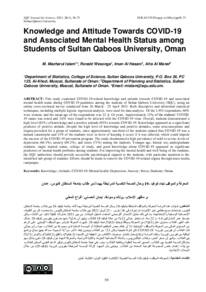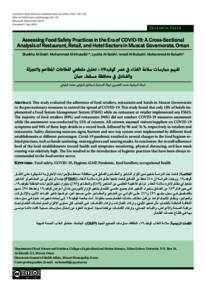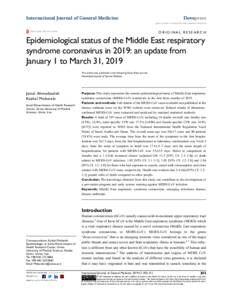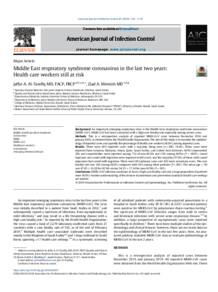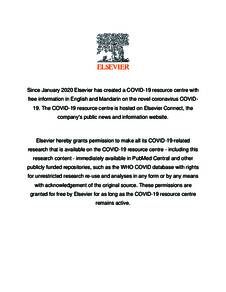وثيقة
Serum bilirubin as a predictor of lipid oxidation in post-covid-19 patients and its association with disease severity.
المصدر
Master's thesis
عناوين أخرى
دور البيليروبين كمؤشر للتأكسد الدهني لدى مرضى ما بعد كوفيد-19 وعلاقته بحدة المرض
الدولة
Oman
مكان النشر
Muscat
الناشر
Sultan Qaboos University.
ميلادي
2024
اللغة
الأنجليزية
نوع الرسالة الجامعية
Master's thesis
الملخص الإنجليزي
COVID-19 disease, caused by the SARS-CoV-2 virus, has been linked to major inflammatory, metabolic, and oxidative stress disturbances, which may extend beyond the acute phase of the disease and contribute to cardiovascular complications. The imbalance between the different oxidant and antioxidant measures is suggested to play a major role in disease progression. Despite its known antioxidant properties, bilirubin's role in post-COVID-19 metabolic manifestations remains underexplored.
Our primary objective was to examine the relationship between serum bilirubin levels and oxidative stress markers in post-COVID-19 patients categorized by disease severity. In vitro, we evaluated the antioxidant effects of bilirubin on human serum through copper-induced oxidation assays. In vivo, we measured serum bilirubin levels and its association with key redox parameters, including reduced glutathione, glutathione peroxidase, malondialdehyde (MDA), oxidized lipoproteins, and antioxidant status as defined by the lag phase in copper-induced oxidation graphs.
The results demonstrated a significant inverse correlation between serum bilirubin levels and disease severity in post-COVID-19 patients with a p-value of 0.039. Bilirubin levels were lower in severe and mild/moderate cases, with averages of 7.08 ± 0.89 and 8.41 ± 0.6 µmol/L, respectively. In contrast, an average of 10.3 ± 0.86 µmol/L of bilirubin levels was reported for the control group. However, lower bilirubin levels were associated with higher MDA levels (R = 0.319, P = 0.003), indicating increased lipid peroxidation and oxidative stress. No significant correlations were observed between bilirubin and other redox measures such as glutathione and glutathione peroxidase. Additionally, oxidized LDL emerged as the primary predictor of MDA levels, indicating a specific link between bilirubin and LDL lipid peroxidation predicting around 7% variation in MDA levels as determined by R2 (p = 0.01).
These findings suggest that bilirubin's antioxidant properties may play a crucial role in mitigating oxidative stress and lipid peroxidation in post-COVID-19 patients. This study highlights a potential role for bilirubin as a therapeutic target for managing oxidative stress-related complications in COVID-19. Future research is encouraged to explore the therapeutic applications of bilirubin and/or its analogs in reducing disease severity and improving clinical outcomes in post-COVID-19 patients.
الملخص العربي
مرض كوفيد-19، الناجم عن فيروس SARS-CoV-2، ارتبط باضطرابات التهابية، وأيضية، وإجهاد تأكسدي كبير، والتي قد تمتد إلى ما بعد المرحلة الحادة من المرض وتساهم في مضاعفات قلبية وعائية. يُعتقد أن عدم التوازن بين مؤشرات الأكسدة ومضادات الأكسدة يلعب دورًا رئيسيًا في تقدم المرض. على الرغم من الخصائص المعروفة المضادة للأكسدة للبيليروبين، إلا أن دوره في المظاهر الأيضية ما بعد كوفيد-19 لا يزال غير مستكشف بشكل كافٍ.
كان الهدف الرئيسي من هذه الدراسة هو فحص العلاقة بين مستويات البيليروبين في الدم ومؤشرات الإجهاد التأكسدي لدى مرضى ما بعد كوفيد-19 المصنفين حسب شدة المرض. تم تقييم التأثيرات المضادة للأكسدة للبيليروبين في المختبر باستخدام اختبارات الأكسدة المحفزة بالنحاس. بالإضافة إلى ذلك، تم قياس مستويات البيليروبين في الدم في الجسم الحي وعلاقتها بالمؤشرات الرئيسية لحالة الأكسدة مثل الجلوتاثيون المختزل، وإنزيم الجلوتاثيون بيروكسيداز، والمالونديالديهيد (MDA)، والبروتينات الدهنية المؤكسدة، وحالة مضادات الأكسدة كما تُحدد بواسطة المرحلة التمهيدية في الرسوم البيانية للأكسدة المحفزة بالنحاس.
أظهرت النتائج وجود ارتباط عكسي كبير بين مستويات البيليروبين في الدم وشدة المرض لدى مرضى ما بعد كوفيد-19 (p-value = 0.039). كانت مستويات البيليروبين أقل لدى الحالات الشديدة والمعتدلة/الخفيفة، بمتوسطات 7.08 ± 0.89 و8.41 ± 0.6 ميكرومول/لتر على التوالي، مقارنةً بمتوسط 10.3 ± 0.86 ميكرومول/لتر في المجموعة الضابطة. ارتبطت مستويات البيليروبين المنخفضة بمستويات أعلى من المالونديالديهيد (R= 0.319، P=0.003)، مما يشير إلى زيادة أكسدة الدهون والإجهاد التأكسدي. لم تُلاحظ ارتباطات ذات دلالة إحصائية بين البيليروبين ومؤشرات الأكسدة الأخرى مثل الجلوتاثيون وإنزيم الجلوتاثيون بيروكسيداز. علاوة على ذلك، برز البروتين الدهني منخفض الكثافة المؤكسد (oxidized LDL) كأهم مؤشر لتوقع مستويات المالونديالديهيد، مما يشير إلى ارتباط محدد بين البيليروبين وأكسدة الدهون في LDL، مع تفسير حوالي 7% من التغير في مستويات MDA (p = 0.01).
تشير هذه النتائج إلى أن الخصائص المضادة للأكسدة للبيليروبين قد تلعب دورًا حاسمًا في التخفيف من الإجهاد التأكسدي وأكسدة الدهون لدى مرضى ما بعد كوفيد-19. تسلط هذه الدراسة الضوء على دور البيليروبين المحتمل كهدف علاجي لإدارة مضاعفات الإجهاد التأكسدي المرتبطة بكوفيد-19. وتشجع على إجراء مزيد من الأبحاث لاستكشاف التطبيقات العلاجية للبيليروبين و/أو نظائره لتقليل حدة المرض وتحسين النتائج السريرية لدى مرضى ما بعد كوفيد-19.
كان الهدف الرئيسي من هذه الدراسة هو فحص العلاقة بين مستويات البيليروبين في الدم ومؤشرات الإجهاد التأكسدي لدى مرضى ما بعد كوفيد-19 المصنفين حسب شدة المرض. تم تقييم التأثيرات المضادة للأكسدة للبيليروبين في المختبر باستخدام اختبارات الأكسدة المحفزة بالنحاس. بالإضافة إلى ذلك، تم قياس مستويات البيليروبين في الدم في الجسم الحي وعلاقتها بالمؤشرات الرئيسية لحالة الأكسدة مثل الجلوتاثيون المختزل، وإنزيم الجلوتاثيون بيروكسيداز، والمالونديالديهيد (MDA)، والبروتينات الدهنية المؤكسدة، وحالة مضادات الأكسدة كما تُحدد بواسطة المرحلة التمهيدية في الرسوم البيانية للأكسدة المحفزة بالنحاس.
أظهرت النتائج وجود ارتباط عكسي كبير بين مستويات البيليروبين في الدم وشدة المرض لدى مرضى ما بعد كوفيد-19 (p-value = 0.039). كانت مستويات البيليروبين أقل لدى الحالات الشديدة والمعتدلة/الخفيفة، بمتوسطات 7.08 ± 0.89 و8.41 ± 0.6 ميكرومول/لتر على التوالي، مقارنةً بمتوسط 10.3 ± 0.86 ميكرومول/لتر في المجموعة الضابطة. ارتبطت مستويات البيليروبين المنخفضة بمستويات أعلى من المالونديالديهيد (R= 0.319، P=0.003)، مما يشير إلى زيادة أكسدة الدهون والإجهاد التأكسدي. لم تُلاحظ ارتباطات ذات دلالة إحصائية بين البيليروبين ومؤشرات الأكسدة الأخرى مثل الجلوتاثيون وإنزيم الجلوتاثيون بيروكسيداز. علاوة على ذلك، برز البروتين الدهني منخفض الكثافة المؤكسد (oxidized LDL) كأهم مؤشر لتوقع مستويات المالونديالديهيد، مما يشير إلى ارتباط محدد بين البيليروبين وأكسدة الدهون في LDL، مع تفسير حوالي 7% من التغير في مستويات MDA (p = 0.01).
تشير هذه النتائج إلى أن الخصائص المضادة للأكسدة للبيليروبين قد تلعب دورًا حاسمًا في التخفيف من الإجهاد التأكسدي وأكسدة الدهون لدى مرضى ما بعد كوفيد-19. تسلط هذه الدراسة الضوء على دور البيليروبين المحتمل كهدف علاجي لإدارة مضاعفات الإجهاد التأكسدي المرتبطة بكوفيد-19. وتشجع على إجراء مزيد من الأبحاث لاستكشاف التطبيقات العلاجية للبيليروبين و/أو نظائره لتقليل حدة المرض وتحسين النتائج السريرية لدى مرضى ما بعد كوفيد-19.
قالب العنصر
الرسائل والأطروحات الجامعية

